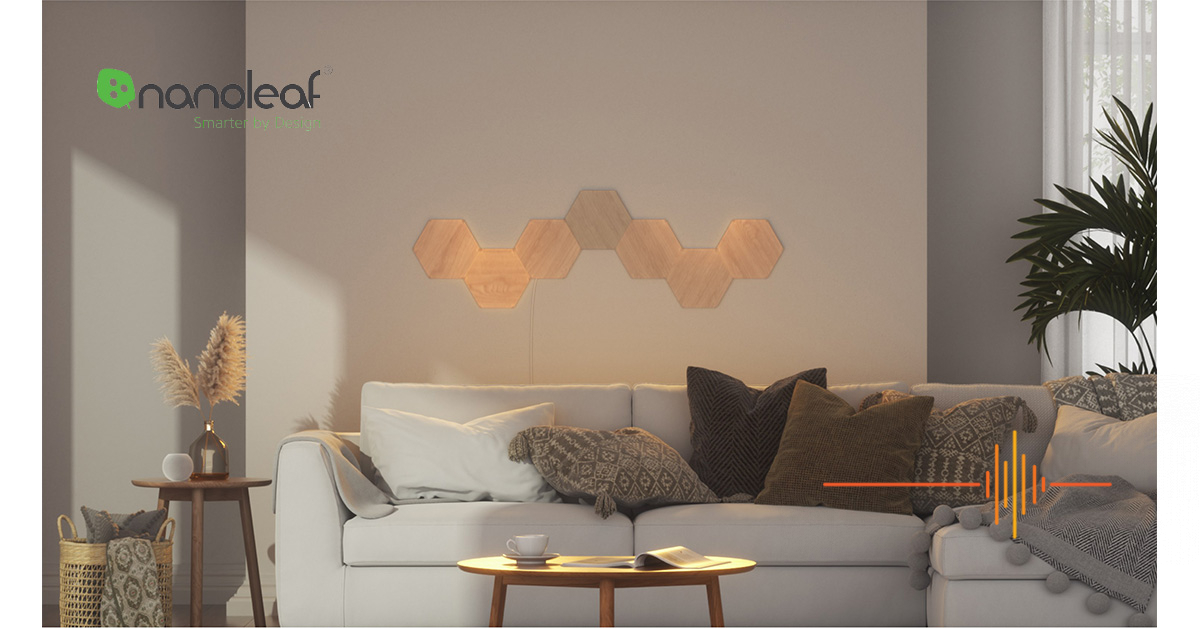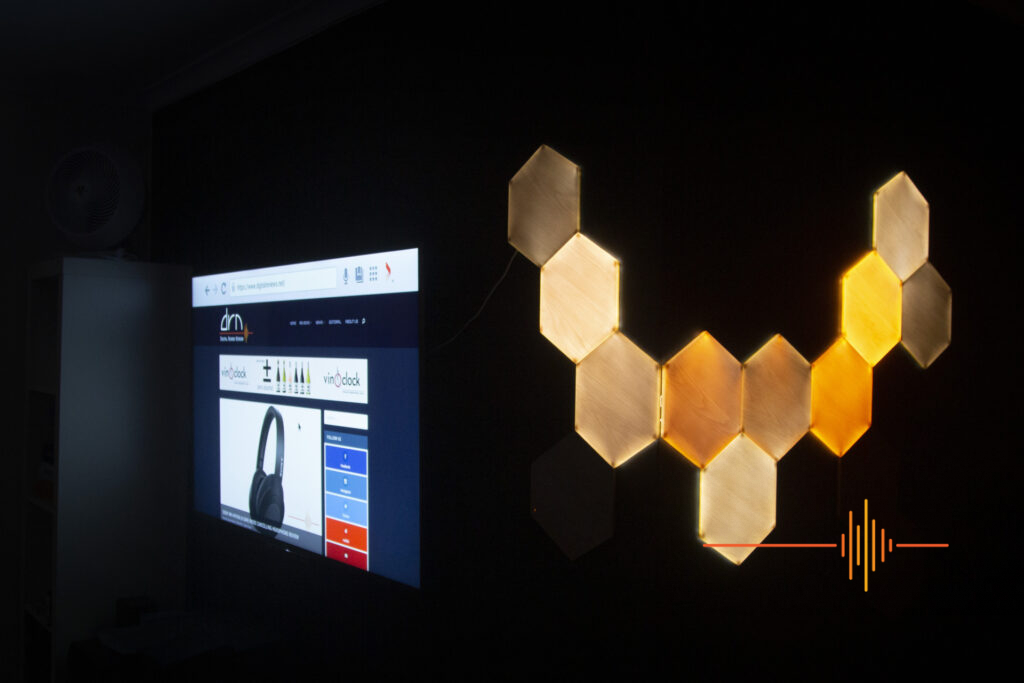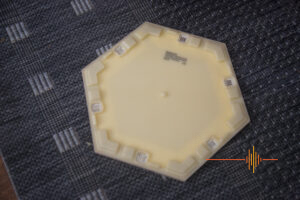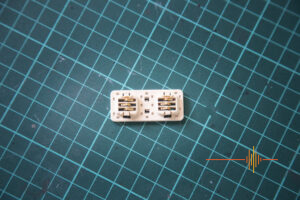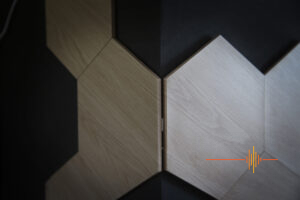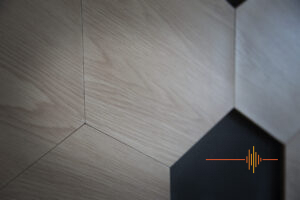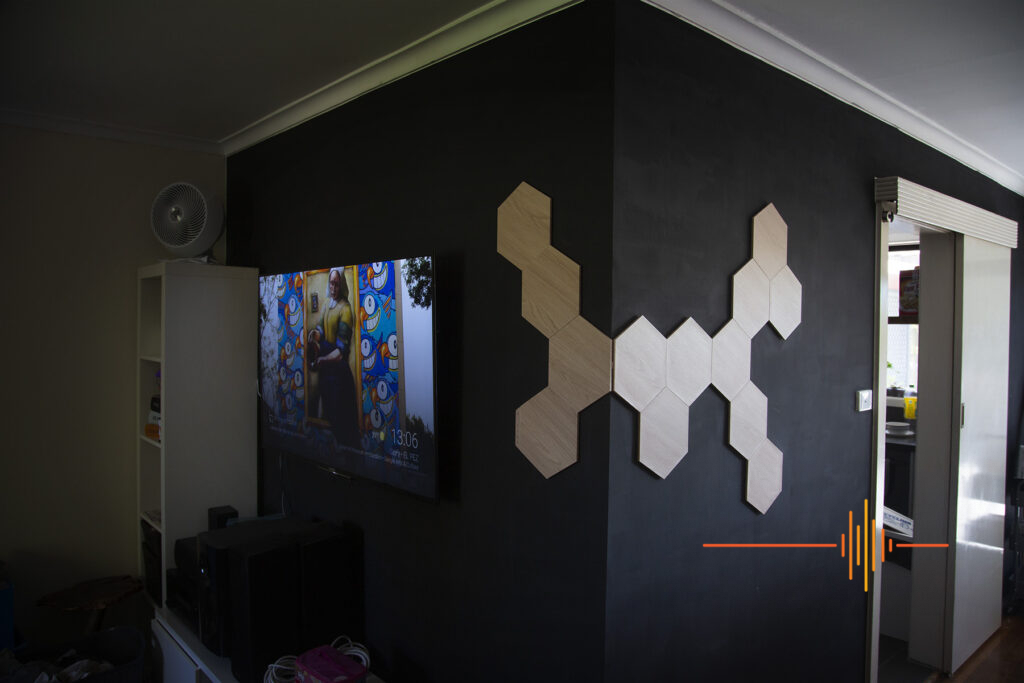Nanoleaf is best known for LED panels in various shapes, such as triangles, squares and hexagons, being used as to add a spark to a room and producing millions of colours. Recently, Nanoleaf have launched the new Elements line, which is a departure from the previous products lines and adding a touch of real class. Instead of popping with a richness of colour, the new Elements range have a refined wood grain texture while off, and show off a warm glow while on. In brief, they live up to their tag line: they are a stunning geometric centrepiece all the time.
When I was in the planning stages to move into my house, I was considering some Nanoleaf Canvas or Shapes to act as a panel of night lights down a long corridor that I have so the kids don’t have to wander in the dark overnight for amenities. We ultimately decided against it given the kids would undoubtedly stay up all night and play with them, and the aesthetics would not suit the room. But the idea of a light panel never really went away.
When the new Elements were announced, something felt right about these. They were no longer a vibrant, colourful, toy-like feature that would draw the kids, but a sophisticated feature which would serve the purpose well. When the opportunity came about with Nanoleaf offering me a chance to try the Elements, it was certainly hard to turn down.
First Impressions
The Nanoleaf Elements Wood Look Hexagons have an authentic wood-textured appearance. For the record here they are not made of wood, but are engineered to create the feeling of real wood along with the grain textures, much like synthetic flooring. More accurately, Nanoleaf describes it as “Laminate with a wood grain finish (PVC).” Running my hands over the panels when I was unboxing them, it is remarkable how well they have mimic the texture and grain of real timber, even under close inspection. It doesn’t quite nail the warmth of real timber but it is an excellent job at mimicking it, right down to different grain patterns for each panel. In that respect I guess it isn’t much different from laminated timber flooring.
The Elements has a display spectrum of warm-to-cool white lighting options, rather than the millions of RGB colours Nanoleaf are generally known for. The colour temperature range is from 1500 to 4000 Kelvin.Think the warmth of your bedside lamp with an old school light globe in it, through to that blue tinged LED light that your phone torch has.
There is also new corner control technology to illuminate each of the panel’s corners independently (more on this later). Given the Elements are in hexagon shapes, that means each of the six corners on every panel has the ability to be independently illuminated. The brightness level has also been dialled down to better suit the more subtle aesthetics, coming from 100 lumens for the Shapes to just 22 lumens per panel in the Elements.
Installation
Step one, plan your installation. Map it out on the floor, or table. Visualise it. Rearrange it until you are happy, then take a photo so you can refer back to it. If you are creatively challenged (like me), the Layout Assistant on the Nanoleaf app can help by letting you experiment with different panel arrangements. There is meant to be Augmented Reality support, but yours truly could not figure out where the option is.
The starter pack comes with 7 panels, a controller and a power adapter. In Australia the only expansion pack is a 3 panels boxing. All of these packs comes with the standard rigid linkers. Nanoleaf has kindly provided me with a Starter Pack and a Hexagon Expansion Pack, which brings me to a total of 10 panels along with some Flex Linkers.
For us, the installation stage also included having to fix the ugly damaged wall in our lounge room. My partner was particularly pleased that a DRN gig had the fringe benefit of getting me to paint some walls in the lounge room. Being the designer that she is, Anita opted for a theatre black wall to showcase the Nanoleaf Elements. Protip: theatre black paint is thinner than normal paint, making it more difficult to work with and harder to cover, but it also shows marks up really easily, too.
Once you have settled on the design of your panels, it is time to mount them on the walls. The standard kit comes with adhesives on the mounting plates, it is as simple as positioning them and sticking them on. The instructions calls for a circular rubbing motion on the panels for 30 seconds to help bond the adhesive to the surface. If you prefer, you can drill some screws into the mount plate where they have provided two helpful holes for this purpose.
It is important to point out that the Elements are faux wood panels complete with wood grains. Be mindful of your installation and how the grain pattern flows. You can rotate the panels on the mounting bracket, and you can pull the actual panels off the mounting brackets and remount them if you have to fix something up.
To really showcase what you can do, we opt to put our design to go around the corner and be on two walls. This means we need the Flex Linkers which needs to be purchased separately.
We mapped out our design and when we started putting our Elements up, we decided that 10 panels is not actually enough and opted for another 3 panel Hexagon Expansion Pack to bring our completed configuration to 13 panels. There is still plenty of buffer until we reach the limit of 22 panels for the standard 42W PSU.
Each edge of the Nanoleaf Elements panel has a linker slot, so it does not matter what orientation you have your panels or which edge is next to each other, you will always have a linker slot to work with. To ensure that you are fully snapping the linkers into the slot, you can have your panels powered on and hot plug each panel – they will come online and light up as you add them. You only need one linker between each panel, but if your design has multiple panels clustered together, you can have multiple linkers into the same panel.
The controller is an optional piece in the setup. You do not have to have them connected and only use your phone and Nanoleaf Smarter Series app. I quite like having the physical controller as it saves me having to grab the phone to do things. The controller is quite discreetly designed to just blend in with the overall aesthetics.
Getting Started
With the physical control panel attached, you can just fire up the PSU and the Elements will power on. Everything you want to do is controllable from here: On/Off; brightness; cycle through Scenes.
To do more, though, you need to use the Nanoleaf Smarter Series app. The instructions are provided on their website but there are three ways to pair your phone to your Elements: QR code (provided on the Quick Start Guide, PSU or Controller) or NFC over the Controller panel are the two obvious ways. All else fails, there is the manual option with a 8-digit pairing code also provided in the three spots mentioned earlier.
Full disclosure here: the Nanoleaf Smarter Series app does not garner a lot of glowing reviews. If you even do a cursory search on pairing with Nanoleaf products you are going to get some horror stories. I did my due diligence before I took the plunge into setting them up, noted potential issues with WiFi protocols, the need for 2.4 GHz as is the case with most IoT devices, and randomised MAC address on Android connections. At first I tried the NFC method, then the QR, and even fell back to manual, and nothing worked. Unfortunately, I simply could not get the Elements to pair to my phone.
I stepped through the process. My mesh unit does not allow me to turn off 5 GHz so I has to busted out an old WiFi range extender that only supports 2.4 GHz. Eventually I just threw my old Pixel 2XL at it instead and it paired just like that. At this point I thought I could cheat and login to my daily driver and have it pick up all the configuration details, but no joy.
Frankly, I was getting pretty frustrated because the last thing I want is to have to use a different phone to control the Elements. That was until inspiration struck and I tried something different. It turns out that my ad blocker on my phone, Blokada 5, interferes with the pairing process as well as the restoring device process. When I turned it off, it magically worked right away. What is more interesting is that once it is setup to go, it stays working even after I reactivate Blokada. Go figure.
First thing to do, of course, is to get the latest firmware. The app showed me v5.2.4 was available which took a few minutes to complete. Shortly after it showed me an update to v6.0.5. The app claims “roughly 3 minutes” to complete which I found a little optimistic. I can’t say whether the firmware could not make a single jump to v6.0.5 or it was just bad timing on my part, but my Elements needed a two stage upgrade.
In Use
At this point, the Elements are fully up to date and working.
It is important to remember that the Nanoleaf Elements are not lights. These panels are the medium to create your personalised visual light art experience.
Each panel can separately light up in a colour temperature range from 1500 to 4000 Kelvin (cool to warm white). The corners of each hexagon does not light up but it looks like a subtle wood joint while the rest of the panels glow. However, light emanating from the corners can be different shades and intensity of white, creating a mesmerising organic sense of motion.
The Elements are preloaded with eleven scenes, which can be cycled through via the controller (if you choose to include it in your installation) or selectable via the app. In the app, the scenes all have descriptive titles such as Bloom, Calming Waterfall, Clouds, Embers. There are plenty of options to download in the Discover tab although there is no filter specific to Elements at time of writing. If you are adventurous, you can create your own Scenes in the app but it does involve a bit of some work.
It is quite surprising at the full colour range you can achieve for white-only LEDs. With the faux wood finish, the range can go from warm oranges to bright white, with subtle shadings that covers silvers, tonals of browns and gold. When you pair it in music mode, you can really set the mood with the light show flickering in sync.
A side note here, the controller does not light up. In my setup at night, it looks as though it does not exist except for the tiny amber indicators. During the day it does look a little odd with the rest of the panels lighting up but you do get over it after a while.
Other Features
Nanoleaf Elements can be integrated with Apple HomeKit, Google Assistant or Amazon Alexa. Given all my smart lights are integrated into Google Assistant, it was the natural integration for me to add the Elements to. The controls are pretty limited though with just on/off and basic colour changing.
The Nanoleaf app itself provides a scheduler to turn the Elements on and set an action, which gives more control than the external integrations.
The app also provides the ability to set Touch Gesture controls, too: double tap, swipe down, swipe up, swipe left and swipe right. With this, it adds a nice ability go up to the light panels and control via touch them to turn them on, brighten and dim them. Does add the risk of them becoming a play feature for the kids, though.
There is an optional 75W PSU which will handle up to 36 panels, or if you fancy, a 75W in-wall PSU to hide those unsightly cables. There are also optional magnetic mounts rather than the standard clip ones.
Lastly Nanoleaf has put a Thread radio on board and have announced a future update that will enable the panel to be a Thread Border Router.
Gripes
I ran into a bunch of issues with the app in particular. And I mean beyond the pairing issue I detailed earlier.
For starters the app is pretty unintuitive. I found myself having to Google how to assign devices to a room and out of the unassigned category to start with.
The second firmware upgrade to v6.0.5 made me think the process bricked the controller. It took a lot longer than the “roughly 3 minutes” the app estimated, and came back with a no connection error. The controller stopped responding to app or physical touch and and in the end, required a hard power cycle and a long wait before it came back to life.
There are some bugs in the app. It can randomly freeze and refuse to launch. I found that I cannot set the double tap gesture in app (but all the other gestures work just fine). It allows me to choose any of the preset functions for double tap, but the selection does not save. Similarly the Circadian Lighting configuration refuses to save any changes.
The Flex Linkers, unlike the standard linkers, are keyed to a certain orientation and has a length of 16.5cm. It does take a little planning and thinking to hide the cable.
Conclusions
The wood look of the Nanoleaf Elements makes it a naturally decorative piece. When the offer to review these first came in, my partner got to thinking how to best showcase it. It led to a long ignored task of fixing an ugly corner of the living room and a general redesign of the room itself. We now have the TV wall mounted, and the Nanoleaf Elements wrapping around the corner from near the TV into the dining room. The theatre black feature wall colour makes the Elements a feature regardless whether they are on or off.
The entire setup in the final configuration included:
- Hexagon Starter Kit NL52-K-7005HB-7PK $429.99
- Hexagon Expansion Pack NL52-E-0001HB-3PK $149.99 (2x)
- Flex Linkers NC04-0070 $15.99
There are limitations yes, the lights are white only and not bright enough other than for ambiance. However as a feature piece it is gorgeous. Whether you go with the preset Scenes, or discover from the myriad of choices available in the app, or deep dive and design your own, these Elements are something you can make as your very own.
DRN would like to thank Nanoleaf for providing the review samples.
Specifications
Height Per Panel : 20 cm
Width Per Panel : 23 cm
Edge Thickness : 0.6 cm
Mounted Thickness : 1 cm
Weight Per Panel : 208 g
Cable Length : 2.5 m
Luminous Flux Per Panel : 22 lumens
Lifetime : 25,000 hours
Communication Protocol : WiFi (2.4 GHz b/g/n) NOTE: 5GHz networks are not compatible with Nanoleaf products.
Dimmability : Yes (via Nanoleaf App, Voice, Touch)
Veneer Material : Laminate with a wood grain finish (PVC)
Mounting Type : Via included double-sided tape or screw mounts (screws and anchors not included)
Key Features : Connect+, Touch, Music Sync, Dynamic Glowing Effect.
Nanoleaf App : Control via the Nanoleaf App (Android & iOS) for mobile/tablet or the Nanoleaf Desktop App (Windows & Mac).
Compatibility : Apple HomeKit, Amazon Alexa, Google Assistant, IFTTT, SmartThings
Colour Temperature : Ambient Whites, 1500-4000K
Colour Channel Configuration : Cool White + Warm White


